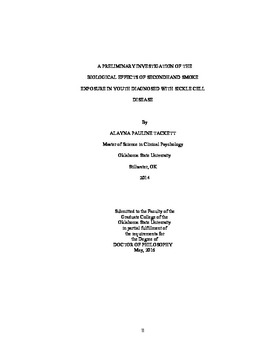| dc.description.abstract | Children's exposure to secondhand smoke (SHSe) can lead to significant health consequences, including respiratory illness, asthma, and impaired pulmonary function. For children diagnosed with a chronic illness, such as Sickle Cell Disease, SHSe can compound an already difficult problem. Among children with SCD, SHSe causes displacement of oxygen from hemoglobin, injury to vascular endothelium, and abnormal activation of platelets, each of which increases the prevalence of sickle cell crises. Sickle cell crises are painful episodes that occur when sickle-shaped red blood cells block blood vessels from providing oxygen to the bodies organs and tissues, resulting in severe pain. To date, no prevalence data or objective measurement of SHSe exists to document rates of SHSe in children diagnosed with SCD. Therefore, the overall aim of the current study is to determine to what extent children diagnosed with SCD are exposed to SHSe. We recruited two groups of families, those who smoke and have children exposed to SHSe versus nonexposed children. Each child from both the exposed and nonexposed group provided a sample of saliva to examine cotinine levels (i.e., object measurement of SHSe). In addition, a medical chart review will provide a preliminary examination of any differences in health care utilization for each group. Thirty-one youth and their primary caregiver were recruited to participate in the present study. Due to equipment failure, four cotinine samples were unable to be processed. The remaining 27 cotinine samples indicated that regardless of parent-reported SHSe, 24 of the 27 children were exposed to SHS. Because 24 of the 27 children were exposed to some level of SHSe, no inferential statistics were utilized. Descriptive statistics regarding tobacco use, perceived harm, and frequency of sickle cell crises, emergency department utilizations, and acute chest syndromes are reported. The findings in this dissertation, particularly those identifying the frequency of individuals exposed to SHSe, indicate a need to assess for SHSe in this population in the future. Future research should aim to better understand and, ultimately, reduce the factors that might increase exposure to SHSe in youth with SCD, and therefore decrease potential harm associated with SHSe. | |
